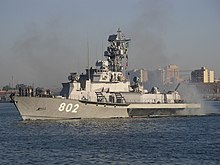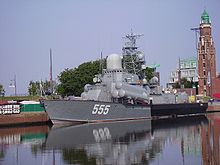Nanuchka class
|
Project 1234 Corvette Vikhr in 1988
|
||||||||||||||
|
||||||||||||||
|
||||||||||||||
|
||||||||||||||
|
||||||||||||||
Project 1234 "Owod" ( Russian "Овод" , German: Biesfliege ), designated by the NATO Nanuchka class , is a class of missile corvettes that was developed in the Soviet Union . The Russian classification of this type is "Small rocket ship" ( Russian "Малый ракетный корабль", МРК ).
history
Because of the development of new anti-ship guided missiles, the high command of the Soviet Navy requested a corresponding weapons platform. What was required was a ship with six starters for the new SS-N-9 missiles, additional artillery and anti-aircraft armament and a high speed. Between 1958 and 1963, three design offices developed different designs.
The final development took over from 1965 the design office "Almas" ( Russian ЦМКБ Алмаз ) in Leningrad under the direction of IP Pegowa.
Planning, however, turned out to be difficult. Due to the heavy weight of the armament, the tonnage rose to over 500 t and there was no suitable drive available to accelerate the ship to the required 35 knots . The installation of the gas turbines existing at the time would have massively increased the tonnage. Six of the existing M-504 diesel engines would have had to be installed for the required speed, which was not possible with the given restrictions on ship dimensions and water displacement. The M-507A diesel engine was therefore developed under great time pressure . In principle it consisted of two coupled M-504s with a total of 112 cylinders.
When project 1234 was examined, due to the displacement , it was decided not to classify it as a small rocket boat ( Russian Малый ракетный катер ), as usual , but as a small rocket ship. Project 1234 was the first type of this classification in the Soviet Navy.
technology
Hull and drive
The hull is 59.3 m long and 11.8 m wide and has a draft of 3.02 m. The standard displacement is 610 t, the maximum 700 t. Three diesel engines of the type M-507 were used as drive, which drove three screws. The maximum speed was 35 kn.
Armament
The armament consists of:
- two triple starters for anti-ship guided missiles P-120 Malachit (SS-N-9 Siren)
- a double-barreled 57 mm AK-725 gun at the rear
- a double starter for 4K33-Osa-M - aircraft missiles at the bow
- four PK-10 decoy launchers
- two PK-16 decoy launchers
electronics
Various radar systems are installed, including:
- Don-2 navigation radar
- Surface and airspace radar peel pair (NATO designation)
- Fire control radar Titanit (NATO: Band Stand ) for SS-N-9
- Fire control radar 4R33 (NATO: Pop Group ) for Osa-M anti- aircraft missiles
- Fire control radar MR-103 Bars (NATO: Muff Cob ) for AK-725
- IFF transmitter High Pole and Square Head (NATO designation)
Ships of project 1234
17 ships of the class were put into service by the Soviet Navy between 1970 and 1982. They have all since been decommissioned - with the exception of the ship Musson of the Pacific Fleet, which sank after an accident on April 16, 1987 in the Sea of Japan.
variants

Project 1234E
Project 1234E was the export version of Project 1234, which was named Nanuchka II class by NATO . The P-120 cruise missile, which was not approved for export, was replaced by the P-20M Rubesch (NATO: SS-N-2C Styx). In addition, electronic systems were changed, especially the fire control system of the anti-ship guided weapons.
In total, the following ships from Project 1234E were handed over to other navies:
India :
- Vijay Durg , formerly Uragan
- Sihdhu Durg , formerly Priboi
- Hos Durg , formerly Priliw
Algeria :
- MRK-21 Ras Hamidou
- MPK-22 Rice Alb
- MRK-23 Salah Rice
Libya :
- MPK-9 Ean Mara , the ship was badly damaged in attacks by American carrier aircraft in the Gulf of Sidra in March 1986 and, after being repaired in Russia, returned to service as Tariq ibn Ziyad in 1991.
- MPK-24 Ean Al Gazala
- MPK-25 Ean Zara
- MRK-15 Ean Zaquit , the ship was sunk on March 25, 1986 during Operation Attain Document III / Operation Prairie Fire in the Great Syrte (Gulf of Sidra) by an American A-6 intruder carrier aircraft.
Project 1234EM ( Russian 1234ЭМ ) is the name of a modernization measure of Project 1234E, which was carried out on ships of the Algerian Navy. The four launch tubes for the obsolete anti-ship missiles of the type P-20 were removed and four launch devices for four 3M24 missiles each were installed. The OSA-M anti-aircraft missile system was converted to the OSA-MA system, which the Russian ships also carry. Furthermore, an AK-630M automatic cannon was installed for close-range defense.
Project 1234.1

Since 1977 modified ships with the designation Project 1234.1 were produced, which NATO named Nanuchka III class . The AK-725 gun was replaced by a 76 mm L / 60 gun AK-176M and a six-barrel AK-630 anti-aircraft gun at the rear was added. In addition, the electronics were extensively changed. In addition to the fire control systems for the new guns, the Mius navigation radar, for example, was installed. The tonnage increased slightly, the top speed dropped to 34 knots. Four additional crew members were required.
Project 1234.7
A ship from project 1234.1 (ship no. 526 Nakat ) was converted as a test platform for the new anti-ship guided missile P-800 Onyx . Two six-way launchers for the new missiles and the associated fire control electronics were installed. According to the NATO nomenclature, the ship type was designated as the Nanuchka IV class .
Current Status
Ships of the Nanuchka II class were still in service in 2004 in Algeria (801 Rais Hamidou , 802 Salah Rais and 803 Rais Ali ), India (K72 Sindhudurg ) and Libya (416 Tariq ibn Ziyad and 418 Ean Zarrah ). In 2004, Russia had 14 ships of the Nanuchka III class and the Nakat of the Nanuchka IV class in service.
Evidence and references
Individual evidence
- ↑ Пистолет у виска империализма. История кораблей проекта 1234. pp. 4–5.
- ↑ Юрий В. Апальков: Апальков Ю.В._Корабли ВМФ СССР. Том II. Ударные корабли. Часть II. Малые ракетные корабли и катера. P. 6.
- ↑ Alexander B. Shirikorad: Miracle Weapons of the USSR - Secret Soviet Weapons. Original title Чудо-оружие СССР - Тайны советского оружия. Verlag Вече, 2005, ISBN 5-9533-0411-0 , Chapter 2.
- ↑ Пистолет у виска империализма. История кораблей проекта 1234. P. 36.
literature
- В. В. Костриченко, В. Е. Кузьмичёв: Пистолет у виска империализма. История кораблей проекта 1234. (for example: WW Kostrischenko, WE Kuzmichew: The gun on the head of imperialism. History of the ships of the project 1234. ) Publishing house Военная книга, 2006, ISBN 5-902863-05-8 (Russian).
- Юрий В. Апальков: Корабли ВМФ СССР. Том II. Ударные корабли. Часть II. Малые ракетные корабли и катера. (For example: Yuri W. Apalkow: Ships of the Soviet Navy. - Part II “Assault Ships”, Section 2 “Small Missile Ships and Boats”. Galea Print, 2004, ISBN 5-8172-0087-2 (Russian)).


